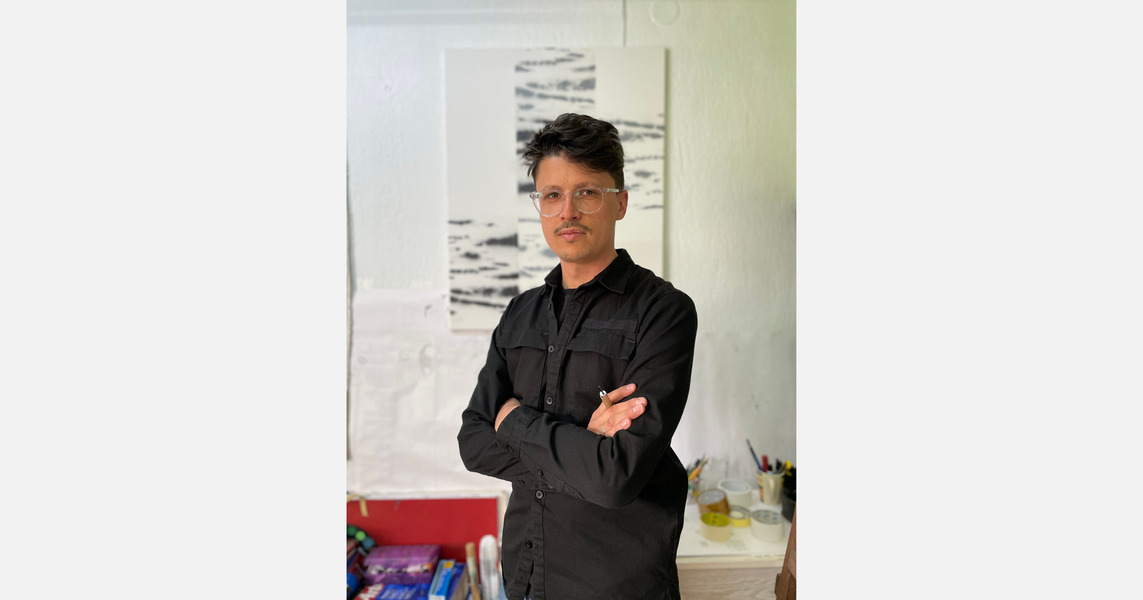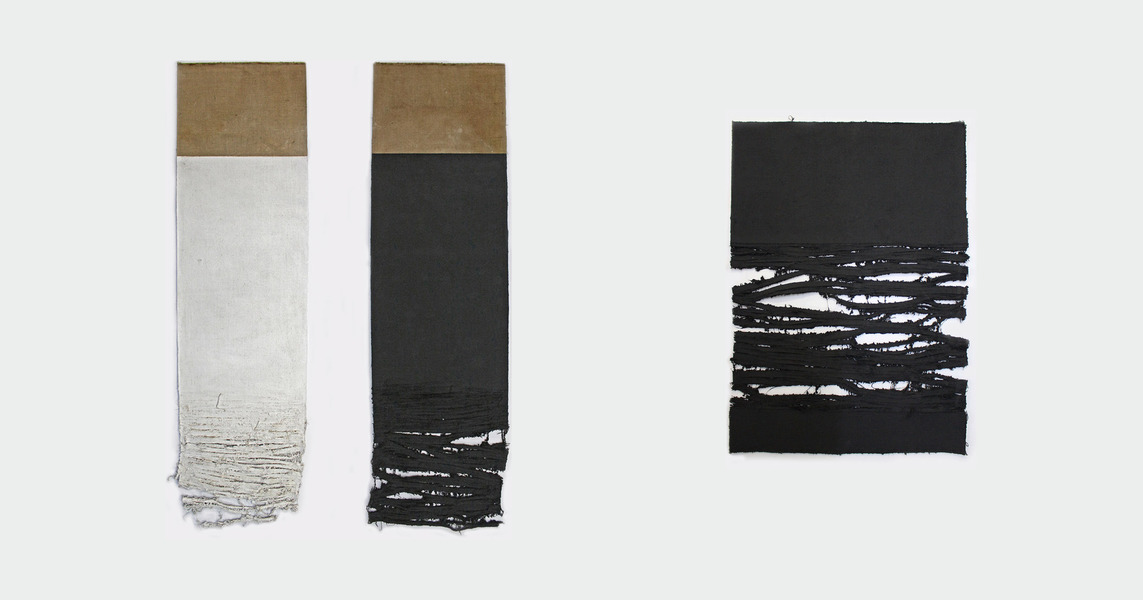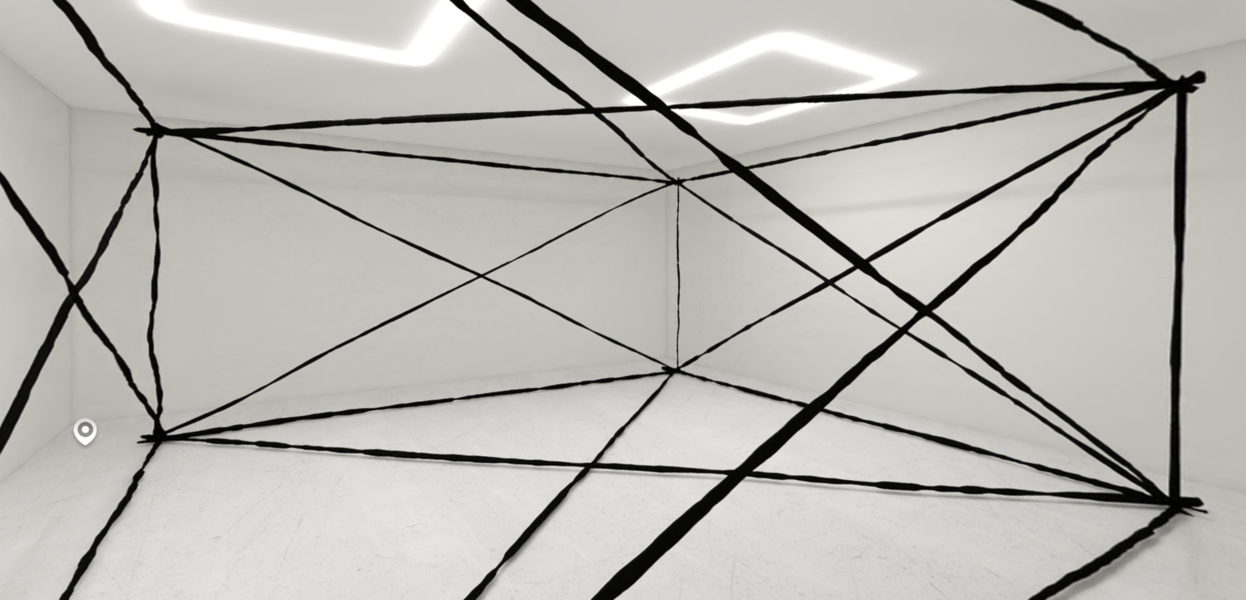Goran Ristovski talks about his position towards spatiality and the ecological aspect of his artistic practice
Published on: 08.11.2021
This conversation took place in Goran Ristovski’s studio in Struga, on April 22, 2021 within the PrivatePrint Meets program and was continued on October 28, 2021, through electronic communication. Goran Ristovski talks about his artistic practice that includes different media, as well as about our cooperation for the Traces exhibition within our VR Studio.

Goran Ristovski
You graduated in the printmaking department at the Faculty of Fine Arts in Skopje, and you work in many different media... What is your approach to the media in which you work?
I am diverse at work. I studied printmaking, but I hardly worked in that field after graduating, especially not in the traditional sense. I am interested in photography, site-specific installation... I work in different media, and I don't know if it is good or not. But I don't think there are rules for an artist to make such a strict structure for himself and create only in one field. I have tried, but it doesn't work for me - to do only drawing or only printmaking, painting, not at all. Although, lately, I've taken up printmaking again. I got some paint, linoleum, and here I started [showing the prints from the Erased Landscapes cycle hung on the wall of his studio].
We know you by the site-specific installations. So tell us more about it.
The site-specific installation is exciting to me; it attracts me a lot. Working on projects with the Inka association, we had the opportunity to make installations and interventions in abandoned areas. For example, last year Filip Velkovski, Dorotej Neshovski, and I made such an installation in a building near Kalishta, right in front of the Izgrev Hotel [on the shores of Lake Ohrid, near Struga]. This is the installation with the yellow room with chairs and another such room [as part of the program "Razdrimuvanje 2020"]. It was an old ruined building; it used to be part of the monastery, a barn. At the time, it was neglected and now is owned by the hotel. That space was literally in ruins, and it was very interesting for us. There was potential for some kind of intervention.
Previously, we also worked on an activist collaboration project at the Cinema Cafe in Struga, when the building was literally in the process of demolition. The windows were removed, and only the walls were left. It looked like an installation. I gathered a team, Filip, Milko, Viki, and Sali, and we worked on an ecological topic with water, stone, mud, and reeds, and we composed a story in that direction. We had five days to work, the exhibition was supposed to last a day or two, then it was over. And in the middle of work, the new owner calls me. They read a statement from us that we are working with an ecologic subject, primarily related to the pressing issues in Struga, burning the reeds, usurpation of the lake, etc. Our critical views towards the environmental policies in Struga led us to a conflict with the owner of the building, who thought that our engagement would hinder him in the construction of the new building. However, in the end, we managed to work things out.
Do you have a different method of working in accessing the other topics you treat?
It's the easiest for me, and I've captured those ideas best through photography so far. I go and do interventions myself, or I catch some other interventions that someone did, more precisely, did damage... I have been very irritated by the bad environmental policy in Struga for the last 15-20 years, so I started to focus on criticism of these policies in my works.
I am very attracted to simplicity and minimalism, in any sense. And when I work, I mostly start by experimenting with the material. I don't plan, for example, to crumple newspapers and create something. It comes spontaneously. And then, I add a little intervention, just to put the work in some context.

Goran Ristovski, Scene without a scene, collaborative site-specific installation, Kalishta, Struga, 2020. Photographs courtesy of the artist
No matter in which medium you express yourself, when we look at your works, we recognize an interest in spatiality...
Yes, that's true. I may already be doing it unconsciously... But definitely, in the sense of the topics and the way the works are set, they are very much related to space. For example, I will exhibit these three prints and a drawing at the group exhibition Escape at the EU Residence in Skopje. They are called Erased Landscapes. But, then, when I take photographs, it's usually in the local open spaces: at the beach, by the lake, someplace else in nature. But I am connected to the spatial aspect. And when it comes to those site-specific installations, I am interested in the object itself and setting it in context. Then I look at how it will affect people, whether they recognize it or not.
It can be said that in the site-specific installations, the topic of ecology, or the engaging aspect of your practice, connects to your way of understanding space.
The chairs and, specifically, the work Sit to be absent consisted of the fact that I put several chairs at different locations in Struga. I took them to the landfill when it was still fresh. It was still small in 2012/3, and almost no one even knew the landfill, just two kilometers from here. I went to another location - to purposely chosen points - and it made sense to communicate with people from there. These are the most neglected locations, which man has either usurped, deformed, or completely forgotten. I set up chairs in the water, in the lake, then near the lake, near the reeds, then in a field... in the city in the middle of the street. And so, with that chair, I wanted to show the disinterested attitude of the person towards those spaces. Or, interested, because we know how people, for their own interests, can usurp a space without considering if it does good or bad, or if they will destroy something. Therefore, I mostly worked within environmental discourse. And that chair tells us: we are here, but we are not entirely here; or tells us: sit down, think...
It irritates me a lot that we don't have a culture of protest, of reaction. I think it's a culture. It has to be developed. To react, to protest. I'm not talking about party protests. I don't know; protests for that landfill did happen after a long time, but it was too late. The garbage there was burning one whole summer, and only then did people come out because they couldn't breathe. So we always wait until the last moment to react.
What keeps you going to your studio and creating something that doesn't necessarily have to be related to an exhibition as a goal?
It has happened to me to just stay in the studio and do nothing. In a way, it is forced to say, now I will create... It doesn't work that way. And I give myself some space, and I say: the moment will come when I will do something. My works so far have come to me, consciously subconsciously. I have been waiting for them. I knew there was a specific potential in an object. So I keep it and make something out of it. I collect some old things; they are here in the studio.

Goran Ristovski, Unfold, installation reusing an old carpet. Photographs courtesy of the artist
But this is also an environmental project for you. You recycle an object.
Preserving or recycling is the first thing I do in everyday life, and I always wonder if all those parts from furniture, household items... Well, where do they all go - in that same landfill, that's where they end up. Then, from that material, I try to make a story. For example, I cut this carpet first with a scalpel into smaller formats and tried to bring in a story from the tradition because we all used to have carpets like this at home, a whole room covered with carpet. And that fashion, a trend from not so long ago, is no longer here. We have rejected it. I wanted to transform these forgotten traditions and fashions and incorporate them into new pieces. The design also attracts me, so I approach an object as a designer. Not only aesthetically, but also how it would look in space, its purpose, and so on.
We remain overcrowded with our works. You will either give them away or throw them away. There are no institutions, collectors…
Yes, that's right. I don't even know how to sell some of the works. If I take these old prints out of the frames, what to do with them. To reuse them for another artwork? For example, it happens, and I want to do this [points to the works made out of reused carpet], but what will I do next when it's done? What will I do with it? And that problem dictates what kind of works you will create. And you limit yourself to smaller formats... By the way, I am a fan of large formats, paintings, and drawings. But where will you exhibit them, where will you keep them?
Given your previous experiences with site-specific installations, can you compare the experience of working in virtual space and in real life through the exhibition Traces realized within PrivatePrint Studio's project VR Studio?
The challenge that comes with a site-specific installation exists in both cases, but of course, conceptualizing for virtual or real space is an entirely different experience. I had to adapt to a different understanding of space. That is the challenge, in my opinion, but it is also an opportunity to achieve results that you would be technically limited to realize in real space.
We know that the artist who lives and works in our cultural context, in addition to creating the works, has to design the way the works will be mounted in a specific gallery space. Well, it often happens that some ideas remain unrealized because of that.
Everyday life is completely digitalized for us, so placing a certain idea-exhibition in a virtual space is yet to be developed in a total sense. And it could be a transition to some other way of presenting works of art. But, in my opinion, that is completely fine. Following modern technologies, we move and immerse ourselves in a different experience as creators and as consumers.

Goran Ristovski, still from the virtual exhibition “Traces”, PrivatePrint VR Studio, 2021
The VR Studio is meant to be a collaborative project. The exhibition does not exist outside the virtual space and is created between the artist, the designer, the curator. What do you think about the opportunity for this kind of collaboration?
Collaborations are essential in the process of creating work. This kind of collaboration, especially with communication between artist, designer, curator, and seen from those three sides, builds a more stable and secure realization of the idea. Because it is about a different way of presenting an idea but more accessible to the audience. With the devices that we use every day: smartphones, computers, laptops, and such, we give and share our new experience to the viewer, at the same time offering them a unique experience. Frequent collaborations of this type are needed, as new practices and experiences, to develop the possibilities for a different approach towards building specific ideas.
Our PrivatePrint Meets program targets young artists at the beginning of their careers and creates in our local context. So, having that in mind, we would like to know how you see the environment in which you work, the art scene you belong to, and the position of the artist?
At one point, our scene lacked visual artists; there were no young artists. But once of a sudden, it started - Klimentina Jauleska, Zoran, Hristijan and I, Gjorgji Krstevski, now there are even more Viki, Milko... and so in Struga, for a small town, there are enough artists. For years we organized the annual exhibition of artists from Struga. Ever since I was in college, I have taken part in it. And that group exhibition became traditional, but I stopped at the 10th anniversary. Nevertheless, the exhibition continued on, there are now even more people, amateurs as well, that take place.
I also like collaborating with other types of artists. We are always open to cooperation; we don't have to be from the same discipline. There are people in the city now.
--
PrivatePrintMeets is a series of meetings with emerging artists from N. Macedonia and is part of PrivatePrint's project activities funded by the Prince Claus Network Partnership programme.
This year, the upgraded VR Studio is co-financed by the Ministry of Culture of the Republic of North Macedonia and made possible through our activities in the PrivatePrint Meets series funded by the Prince Claus Network Partnership Programme.